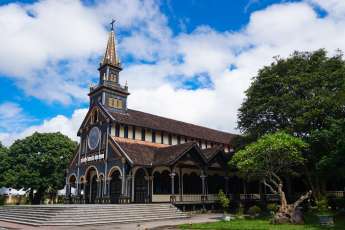
4 reasons to fall in love with Northern Vietnam
- on Jun 28, 2023 By: Ngoc Nguyen
The attraction of North Vietnam for travellers is undeniable. Many are seduced by this region of great beauty. But why do travellers include this region as a priority in their trip to Vietnam?
For its spectacular landscapes

The North of Vietnam is undoubtedly the region that contains the most breathtaking landscapes in the country. The North of Vietnam is home to two UNESCO natural heritage sites: the magical Halong Bay and the sumptuous landscape site of Trang An. The first, known worldwide for its limestone lace knitted by water, wind, and millennia, is the tourist showcase of Vietnam. A cruise with one night on a traditional cruise is a must-visit to explore this exceptional site. The second, commonly referred to as the “Halong Bay on land”, is characterized by a stunning limestone tangle emerging from a river-streaked rice plain. This site of great beauty, which houses pagodas and ancient temples, can be visited by rowing boat or bicycle. Within it, you can also visit the former royal capital of Hoa Lu.

If travellers love the landscapes of Northern Vietnam so much, it is also for its overlapping mountain ranges. If we find alpine mountains in the West, we have Fansipan Mountain in the Indochinese Peninsula as its highest point and its 3.143 meters more jagged, which is reminiscent of landscapes of prints. The region of Ha Giang, in the far Northeast, is also distinguished by its incredible geopark of the Dong Van karst plateau, recognized as a world geological park by Unesco. Cao Bang province with its forests of limestone peaks covered with vegetation announces the limestone enchantment of Halong. Hikers, as you guessed it, have found an extraordinary playground here.
The rice terraces tumbling down the mountains never cease to stun travellers exploring Northern Vietnam. Shaped by the single hand of man, the rice terraces mark some of the most spectacular landscape sites in Vietnam and even in Southeast Asia.
>> Read more: Rice terraces in Vietnam, the most beautiful mountain scenery
For its incredible ethnic diversity

The grandiose mountains of Northern Vietnam are the territory of an incredible ethnic mosaic. More than thirty ethnic minorities share these fabulous settings. If the Hmong are the masters of the altitudes, the Thai and the Muong invest in the valleys. Tay, Nung, Ha Ni, etc. live in harmony in the middle altitudes. Steeped in centuries-old traditions, these ethnic groups live in timeless villages, sometimes in wooden houses on stilts, and the women proudly wear their traditional costumes competing in colours and tribal patterns. Ethnic markets, numerous in North Vietnam, are one of the expressions of their strong cultural identity. Spending a night with the locals will be an excellent opportunity for you to immerse yourself in their fascinating culture and observe their daily life.
To enjoy a cuisine as tasty as it is varied

Gourmets agree that Northern Vietnam is one of the most indulgent regions. Northern Vietnamese cuisine is, for many gourmets, the quintessence of popular traditional Vietnamese cuisine. What kind of traveller has not succumbed to a bowl of pho, the famous divinely flavoured Vietnamese soup, or bun cha, rice vermicelli accompanied by grilled pork balls? Less spicy, greasy, or sweet than those of the Centre and the South, the cuisine of Northern Vietnam gives pride of place to vegetables, aromatic herbs, and seafood, such as the delicious cha ca, a fried fish with turmeric on a bed of dill and chives. Even more than elsewhere, it is in Hanoi that travellers titillate their taste buds with its legendary street food. On the sidewalk, in a joyful fair atmosphere, you will be able to make great culinary discoveries!
>> Read more: Top 10 unmissable dishes in Hanoi
For its capital, vibrant and lively

The thousand-year-old capital of Vietnam is widely acclaimed by travellers who hail its frenzy, its atypical street scenes, its many museums, its neighbourhood life, its formidable colonial architectural heritage, its amazing street food, its many temples and pagodas, and its lakes which are so many oases of tranquillity in a city bubbling with energy and vitality. Despite the chaotic traffic, travellers enjoy strolling through Hanoi's Old Quarter where the merchant activity is absolutely stunning. They appreciate the intersection of two cultures, to sit on the terrace of a cafe to watch the street come alive, especially with women carrying yokes on their shoulders or pushing the bicycle which was filled with flowers like a ballet on a two-wheeler.
>> Read more: Hanoi city and its old quarter
Which season should we go to discover the North of Vietnam?
Unlike the other two regions of Vietnam, the North has four seasons. It is best to avoid winter which can be cold and wet and to favour the months of April, May, September, October, and November to make the most of this sublime region.
Related articles:
>> Diving in Vietnam: 5 destinations not to be missed
>> The 15 most beautiful destinations in Vietnam
>> Loop in the North-West of Vietnam, what to see and what to do?
 Español
Español Français
Français







.jpg)

.jpg)










Morgane Ter Cock
on Dec 18, 2025HerbertPhomaMS
on Oct 19, 2025Lilyan Cuttler
on Oct 15, 2025Avenue17XC
on Sep 14, 2025Avenue18JL
on Jul 21, 2025